Whether you are on a road trip through Italy or fancy a day out from Bologna or one of the other Italian cities, don’t miss out on the beautiful city of Ravenna. Just a short train journey from the centre of Bologna through the beautiful countryside.
Famous for its mosaics, Ravenna sits to the southeast of the Emila-Romagna province in Italy’s northeast and is the capital city of the Province of Ravenna. It has had a rich and fascinating history, having been a major city in the area since the Roman Empire. It has also served as the capital of the Ostrogothic Kingdom, the Byzantine Empire and the Kingdom of the Lombards.
*This site uses affiliate links and I may earn a small commission when you use my links and make a purchase without incurring an additional fee yourself.
Thank you for supporting this website. See my disclaimer page for more details.
Why go to Ravenna?
Ravenna is an enchanting city full of ochre and terracotta buildings, basilicas and churches, open piazzas, and amazing mosaics that adorn many of its main buildings, which makes it the perfect place for history and art lovers. Many of the mosaics date back to the 5th and 6th centuries and the Roman and Byzantine Empires.
What can you see in Ravenna?
Ravenna is filled with beautiful architecture and stunning mosaics and it is home to no fewer than eight UNESCO World Heritage sites: that alone makes Ravenna worth visiting. Virtually every corner you turn there is a church, a boutique, or a coffee shop to enjoy, however here are seven of the best of the Basilicas and Monuments:
Basilica di San Vitale

The Basilica di San Vitale is one of the most important examples of early Christian and Byzantine architecture in Europe and is one of the eight UNESCO Heritage sites in Ravenna. With its octagonal design, merges both Roman and Byzantine elements, with domes, flying buttresses, stepped towers and shaped doorways, it is an interesting building to admire from the outside.
Inside the Basilica are stunning mosaics from the 6th Century and frescos from the 18th Century. On one side the Byzantine mosaics depicting various scenes from the Bible are still visible. There are also mosaics representing Justinian I and opposite Theodora, the Emperor and Empress of the Eastern Roman Empire.
The queues to get into the Basilica can get very, very long so it might be worth heading here first.
Address:
via San Vitale, Ravenna
Entrance cost:
Part of the combined ticket of €9.50 with Mausoleum di Galla Placidia, Basilica di Sant’Appollinare Nuovo, Battistero Neonaino and Museo Archiescovile e Capella di Dan’Andrea
Entrance times:
March to October: 09:00 to 19:00 (last entry 18:45)
November to February: 10:00 to 17:00 (last entry 16:45)
YOU MIGHT ALSO LIKE: Best Weekends in Italy
Mausoleum di Galla Placidia
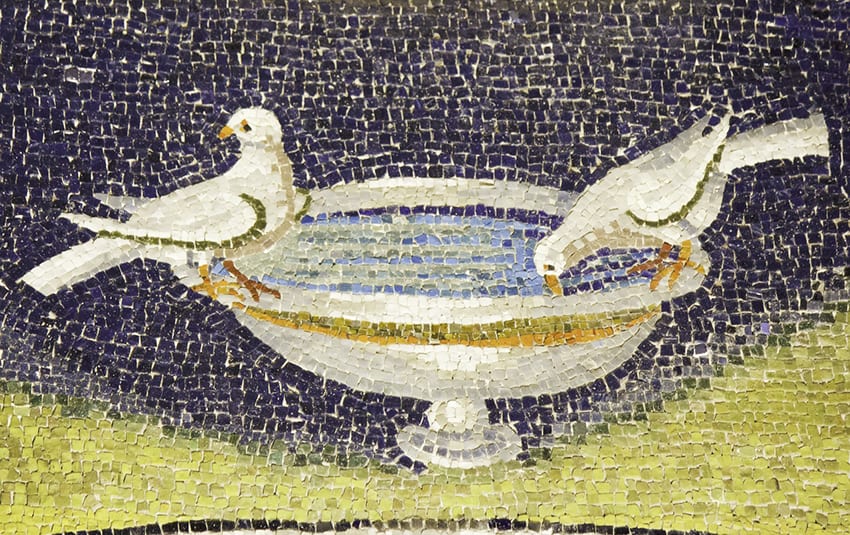
Another of the sites on the UNESCO World Heritage List, the Mausoleum di Galla Placidia is in the same churchyard as the Basilica di San Vitale.
The Mausoleum has three sarcophagi which are alleged to hold the remains of Aelia Galla Placidia (388-45oAD), her husband Emperor Constantius III and the final sarcophagus contains either her son Emperor Valentinian III or her brother Emperor Onorio.
The walls of the Mausoleum are covered in amazing, colourful mosaics including four of Christ’s apostles as well as other representations of life over death. After visiting Ravenna during his honeymoon, in the 1920s, the vaulted ceiling of a starry sky inspired Cole Porter to write his famous song “Night and Day”.
Address:
via Giuliano Argentario 22, Ravenna
Entrance cost:
Part of the combined ticket of €9.50 with Basilica di San Vitale, Basilica di Sant’Appollinare Nuovo, Battistero Neonaino and Museo Archiescovile e Capella di Dan’Andrea
Entrance times:
March to October: 09:00 to 19:00 (last entry 18:45)
November to February: 10:00 to 17:00 (last entry 16:45)
Basilica of Sant’Apollinare Nuovo

With its arched exterior and simple windowed tower, the Basilica di Sant’Appollinare Nuovo hides its beautiful interior. Walk through the doors and you are stunned into silence.
Both sides have a line of decorated arches topped with the most amazing mosaics, the gold tiles glinting in the sunlight and with more mosaics and arched windows above. The roof is covered in painted and gilded squares. I sat on the steps and just stared in awe at the mosaics. It is so simple and yet so beautiful.

The murmur from tourists gets louder and louder and there are regular “Shhhh” announcements which quieten the crowd for about 30 seconds!
Address:
via di Roma 52, Ravenna
Entrance cost:
Part of the combined ticket of €9.50 with Basilica di San Vitale, Mausoleum di Galla Placidia, Battistero Neonaino and Museo Archiescovile e Capella di Dan’Andrea
Entrance times:
March to October: 09:00 to 19:00 (last entry 18:45)
November to February: 10:00 to 17:00 (last entry 16:45)
YOU MIGHT ALSO LIKE: 10 Day Trips from Bologna
Battistero Neoniano

The exterior of the Battistero Neonaino is a simple octagonal brick building, but step inside and you are transported. In the middle is a large marble bath that was used for the actual baptising. The walls surrounding it are adorned with murals and if you look up, the ceiling takes your breath away.
The intricate mosaic on the ceiling shows the baptism of Christ by John in the river Jordan in the middle and the 12 disciples around the edge.
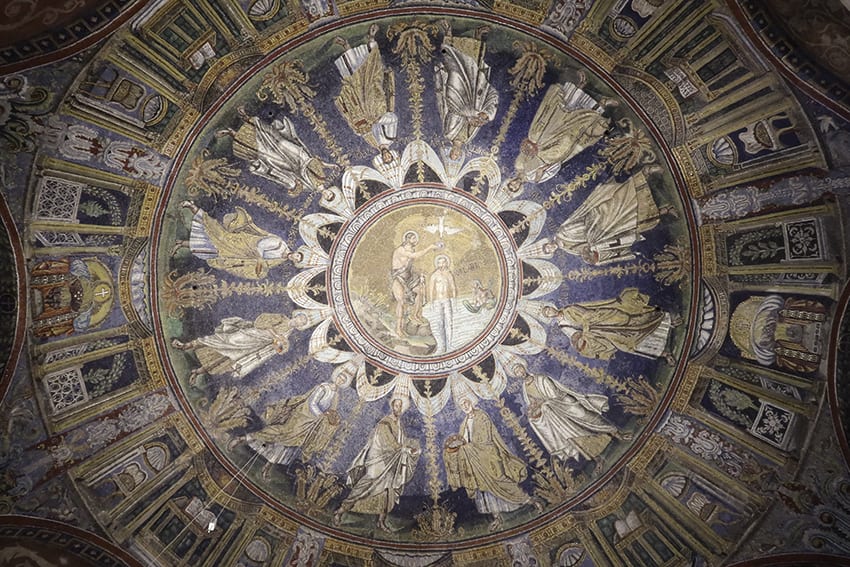
The Battistero dates from the 5th Century, but some of the mosaics were renovated in the 19th Century. It is small and intimate but it has a magical feeling inside of peace inside. The arched windows flood the place with light which makes the gold mosaic tiles glow and adds to the atmosphere.
Address:
piazetta degli Ariani, Ravenna
Entrance cost:
Part of the combined ticket of €9.50 with Basilica di San Vitale, Mausoleum di Galla Placidia, Basilica di Sant’Appollinare Nuovo and Museo Archiescovile e Capella di Dan’Andrea
Entrance times:
March to October: 09:00 to 19:00 (last entry 18:45)
November to February: 10:00 to 17:00 (last entry 16:45)
YOU MIGHT ALSO LIKE: Best Castles in Italy
Museo Archiescovile e Capella di Dan’Andrea
On the other side of the Duomo di Ravenna is the Museo Archiescovile which houses artefacts and from buildings that have been demolished including the ancient city cathedral. The ivory throne of Maximian is one of the most interesting pieces as it is one of the most famous 6th Century carved ivory works by Byzantine artists.
Note: The museum prohibits photos being taken!
Address:
Piazza Arcivescovado, 1
Entrance cost:
Part of the combined ticket of €9.50 with Basilica di San Vitale, Mausoleum di Galla Placidia, Basilica di Sant’Appollinare Nuovo and Battistero Neonaino.
Entrance times:
March to October: 09:00 to 19:00 (last entry 18:45)
November to February: 10:00 to 17:00 (last entry 16:45)
Dante’s Tomb
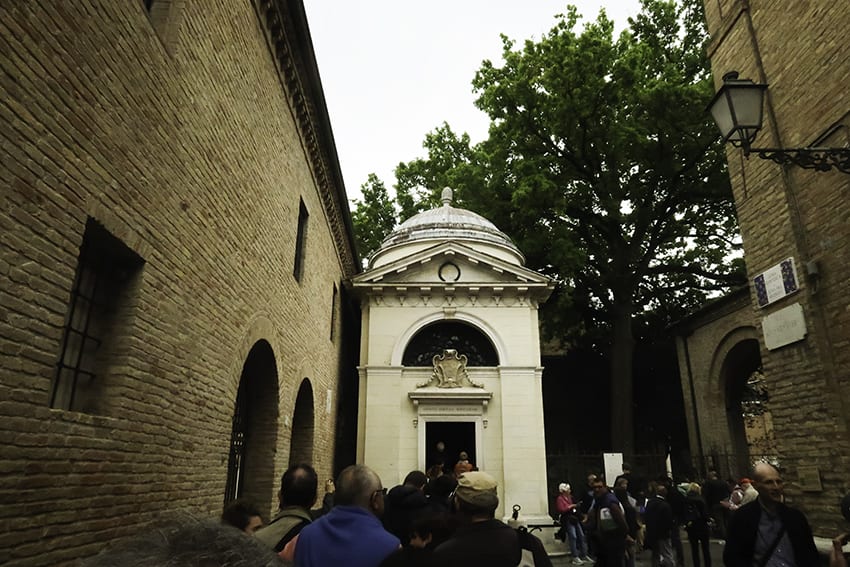
Just off Piazza Giuseppe Garibaldi, at the end of Via Dante Alighieri is the Tomb of Dante. The small marble mausoleum in a neo-classical style houses the original sarcophagus containing Dante’s bones.
Although he was born in Florence, the great writer Dante Alighieri had been in exile and lived in Ravenna for three years before he died in September 1321, nearly 700 years ago.
If you get there early you may not have to queue, but even if you do, the queue does seem to move quite quickly. Once you get to the tomb, you can look into the marble interior and take photos, but you can’t actually go into the tomb itself.
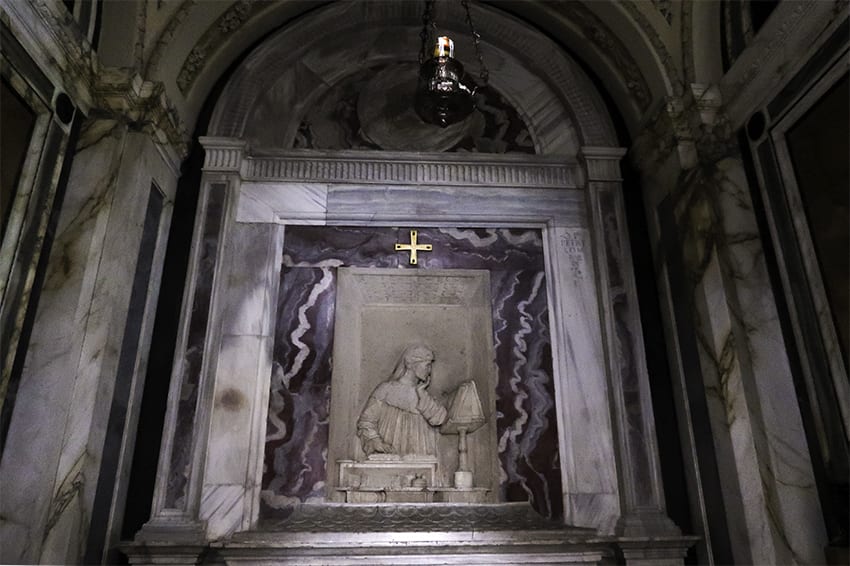
You may notice on the wall outside there is a sign saying “Zona Dantesca, Zona del Silenzio” or in English “Zone of Dante, Zone of Silence”; the area is meant to be an area of silence, but I have to admit that most people did not heed this and there was a lot of chatter.
Address:
via Dante Alighieri 9, Ravenna
Entrance cost:
Free
The Basilica of Sant’Apollinare in Classe
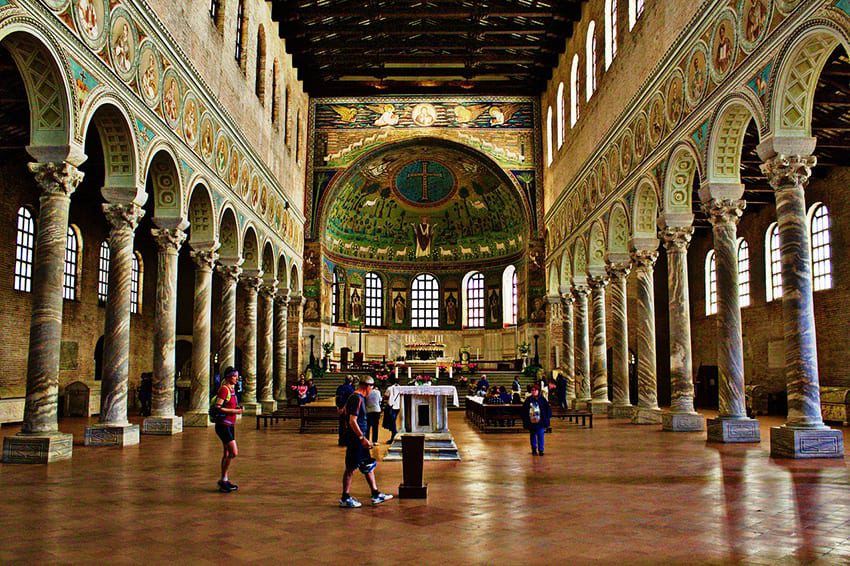
The Basilica of Sant’Apollinare is about 8km outside of Ravenna and is considered to be an important Byzantine monument worthy of its UNESCO World Heritage Status. It was consecrated in 549 AD.
To get to The Basilica of Sant’Apollinare you can either take an 8-minute train from Ravenna or a 13-minute bus ride costing between €1 and €3.
Address:
via ia Romea Sud, 224, 48124 Classe
Entrance cost:
€5
YOU MIGHT ALSO LIKE: Best Weekends in Italy
How to get to Ravenna:
Ravenna is very easy to get to by train. From Bologna Centrale, it takes between 59 minutes to an hour and a half depending on whether it is a fast or slow train and costs from €8 for second class (correct at July 2023).
If you are going off on a cruise from the Porto Corsini cruise terminal to Venice, consider combining a trip to Ravenna. It is quite easy to get to the terminal from Ravenna Train Station.
Places to stay – hotels and apartments to book in Ravenna
Tips & Advice:
Get there early
I know this is the same advice for most places you visit, but I arrived in Ravenna at around 12 pm (it was a spur-of-the-moment decision to go) and because of the queues I did not get to see all the things I wanted to. So, if you can, get there early.
Get an entrance ticket first
Okay, I have to admit that I joined the queue outside of the Battistero Neoniano and it was only when I got to the front of the queue that I realised that I needed a ticket to get in. I nipped around the corner, waited in line to buy my ticket, and then joined the queue again before I got in.
For €9.50 you can get a ticket which gives you entrance to five of the monuments. The tickets are valid for 3 days and you can get them from the bookshops located near the following places:
- Basilica di San Vitale, via Argentario 22, Ravenna
- Basilica of Sant’Apollinare Nuovo, via di Roma 53, Ravenna
- Archiepiscopal Museum, piazza Archivescovado 1, Ravenna
- Battistero Neoniano, piazza Battistero 1, Ravenna
Remember many of these are active places of worship
We sometimes forget when we step into awe-inspiring buildings that they are not there just for our touristic pleasures. Many of the places to visit in Ravenna are places of worship and should be treated with the reverence they deserve:
- Keep your voices low, or silent
- Wear appropriate clothing as you may not be allowed entrance if you are inappropriately dressed
- Follow guidelines for using cameras, flash, video, selfie sticks etc
- Turn your phone to silent, especially in a place of worship
- Don’t drink or eat inside the monuments
- Don’t touch things you are not meant to
For a list of tours, have a look at Get Your Guide’s listings for Ravenna.
Like it and want to keep it for later? Pin it!



Use these Italy Travel Tips to plan your adventure!
- Plan your trip with these Italy Travel Guides.
- Get the best deals on flights with Skyscanner.
- Find the perfect place to stay in Italy on Booking.com.
- Explore more about Italy with local experiences.
- Don’t forget to arrange your travel insurance.
- Learn Italian with an Intrepid Italian Course.

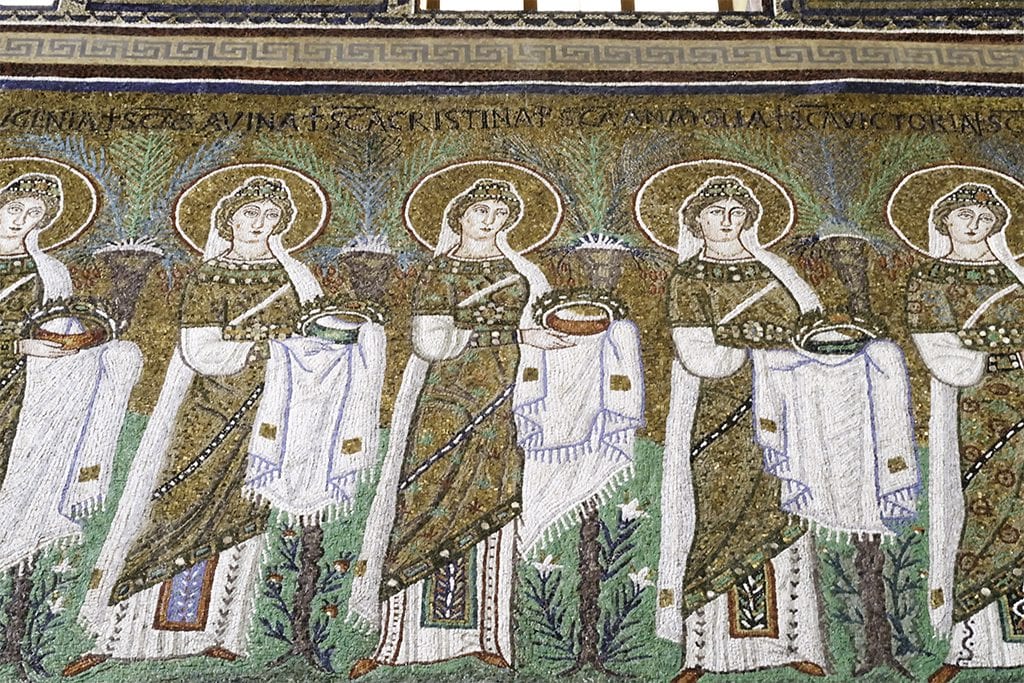
What beautiful photos! I’m definitely adding this to my list.
Thank you Jenny, it is a lovely place to visit!
We’ve spent a lot of time in Italy although never be to Ravenna. Your highlights look great so we must put it on the agenda for next time.
I highly recommend it, Karen, Ravenna is a delight to visit. I definitely will be going back again
The insides of those buildings are just BEAUTIFUL!!
They are so magnificent Katy, I sat down on a step and just gazed at them transfixed for about 15 minutes.